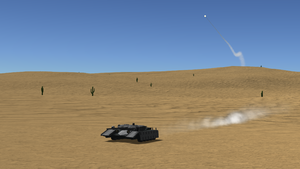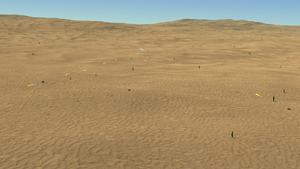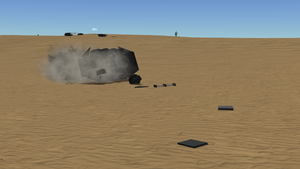Wurst War
The Wurst War was a war fought in 2124 and 2125 between Wurstian Warlords, designated as terrorists by Phoenia, and an International coalition consisting of Phoenia, Orion, Elohim, Belka and the Gallente Federation. It was started by rebel attacks on Phoenian Border towns in 2124, which some "conspiracy theorists" still claim were a false flag operation. The war ended in a hard fought, and bloody victory for the coalition, resulting in Phoenian annexation of Wurst in it's entirety, containing both the rebel and government controlled areas. Coalition actions during the war came under UKN scrutiny, resulting in the formation of it's Wurst Tribunal, and a War Crime trial.
Background
During the 2110's, Wurst as a nation was mostly aligned with Nuvastia, with a large part of the country being Nuvan. However, in 2120, after population changes due to the rising Phoenian state, and worsening quality of life in Nuvastia and it's spehere of influence, Wurst suffered a bloodless coup, which lead to the installation of a neutral, less Nuvastia-alligned government. In response to this, in 2121, a coalition of Ethnically Nuvan Wurstian rebel and mercenary groups announced their plans to take control of Wurst, and depose it's government, returning to the pre-coup one. They launched an insurgency located in the countries north, securing the majority of the region by the end of 2122.
Run-up to War
In 2123, the Wurst warlords begun executing cross-border raids into Phoenia, officially aimed at sabotaging Phoenian influence campaigns in Wurst. The Phoenian response was far stronger than expected with them considering the act a declaration of war, and in early 2124 Phoenia began assembling an international coalition to deal with the Wurstian threat. The coalition included Phoenia's allies in Orion, Gallante, Elohim and Belka, who all sent their expeditionary units into Phoenia to prepare for war.
War
Early Actions
The first offensive action of the war was taken by Elohim, with an aggressive reconnaissance and SEAD mission launched following the formal declaration of war on Wurstian Warlords by Coalition forces. The Strike package consisting of 28 Aircraft (of those, 16 Fighters and 12 heavy attack aircraft) entered Wurstian airspace before being intercepted by Wurstian Rebells Airforce Z-80 Lancer's, and Wurstian Air Defenses. The air fight resulted in a loss of all aircraft for Elohim, who despite that managed to inflict significant casualties to the WRAF and Air Defenses. Elohimian losses for the battle were estimated at about 2 000 000 funds.
Following the morning's failure, Gallante Federation Aircraft entered Wurste in the evening, against coalition orders, and engaged the WRAF Aircraft over their air defense net. Seeing the danger in the attack, Elohim sent their own air forces into the fray as well to assist Gallante forces. The attack was again a failure, with the coalition losing some 140 aircraft to the WRAF Z-80 Lancers and air defenses.
Day one losses to the coalition amounted to 8 000 000 funds, and over a 100 Coalition Pilots killed, with another dozen captured. Following the setback, the coalition ceased offensive actions to regroup and organize, and to hopefully avoid such mistakes and disobeyment of orders.
Second Phase
After a pause in offensive actions, the Phoenian Coalition began reorganization, to avoid mistakes such as those made on day one. The military command of coalition forces was shifted to Orion, and their commanders took control of the forces from the Aircraft Carrier Illustrious in Phoneian waters. The first actions under the new command were SEAD Missions, this time conducted from beyond Wurst borders using aircraft, naval nissile attacks and orbital strikes from the OSF Space Fleet. These attacks proved as highly successful, and Orion forces took out majority of the Wurstian air defense using these strategies. Belkan commanders notably opposed some of the changes, believing that the solution was to begin a strategic bombing campaign, with the goal of punishing Wurst and it's population for supporting the terrorists. The rest of the coalition considered these plans barbaric and refused to implement them.
Those attacks were followed by an air engagement, with the Phoenian Air Force attempting to take out the remnants of the WRAF Lancer's. 50 Phoenian Swift and Liberator model fighters entered Wurstian airspace, and engaged the fighters launched to intercept them. A fight ensued, eventually ending in a loss for Phoenia, with 42 aircraft shot down, while the final 8 retreated. However, Wurste also lost 35 Z-80 Lancer aircraft from their diminishing airforce stocks, and as such the coalition effectively took air supremacy. Another round of Orbital and Naval strikes followed, destroying what remained of the Wurstian air defenses, and forcing the Wurstian ground forces to move into denser populated areas to avoid bombardment. Having taken air supremacy, the coalition now began using their air forces to strike strategic targets, such as communication points, electrical transformers, air fields and more. This would last multiple months, before Coalition armor would cross beyond their initial incursion into Wurst, and engage the Wurste ground forces. As Wurstian tanks were usually followed by civilians supportive of the Warlords, the coalition could not strike them from the air.
The ground war
After months of bombing and missile strikes, Coalition armor would finally cross the border of their initial incursions, thus beginning the ground campaign. Undeterred by Wurstian Mortar fire, Elohimian, Phoenian MBT-3 and Orion K-04 Tanks pushed into Wurst, meeting limited resistance from Wurstian Rhodie tanks. 1 week in, the two Coalition armored columns met up and proceeded into what would be the decisive battle, meeting the remaining 150 tanks of Wurste, supported by ATGM squads hidden in buildings and bushes. 300 Coalition tanks entered the fight
The fight ended in Coalition victory, with most Wurst tanks destroyed, and a couple remaining ones surrendering. Coalition ground forces showed their exceptionalism, losing only 34 tanks while taking out almost 150. This was the final engagement of the war, as right after it's conclusion, the Wurstian Rebels surrendered unconditionally to Coalition forces, and total victory in the war was declared for the Coalition forces.



